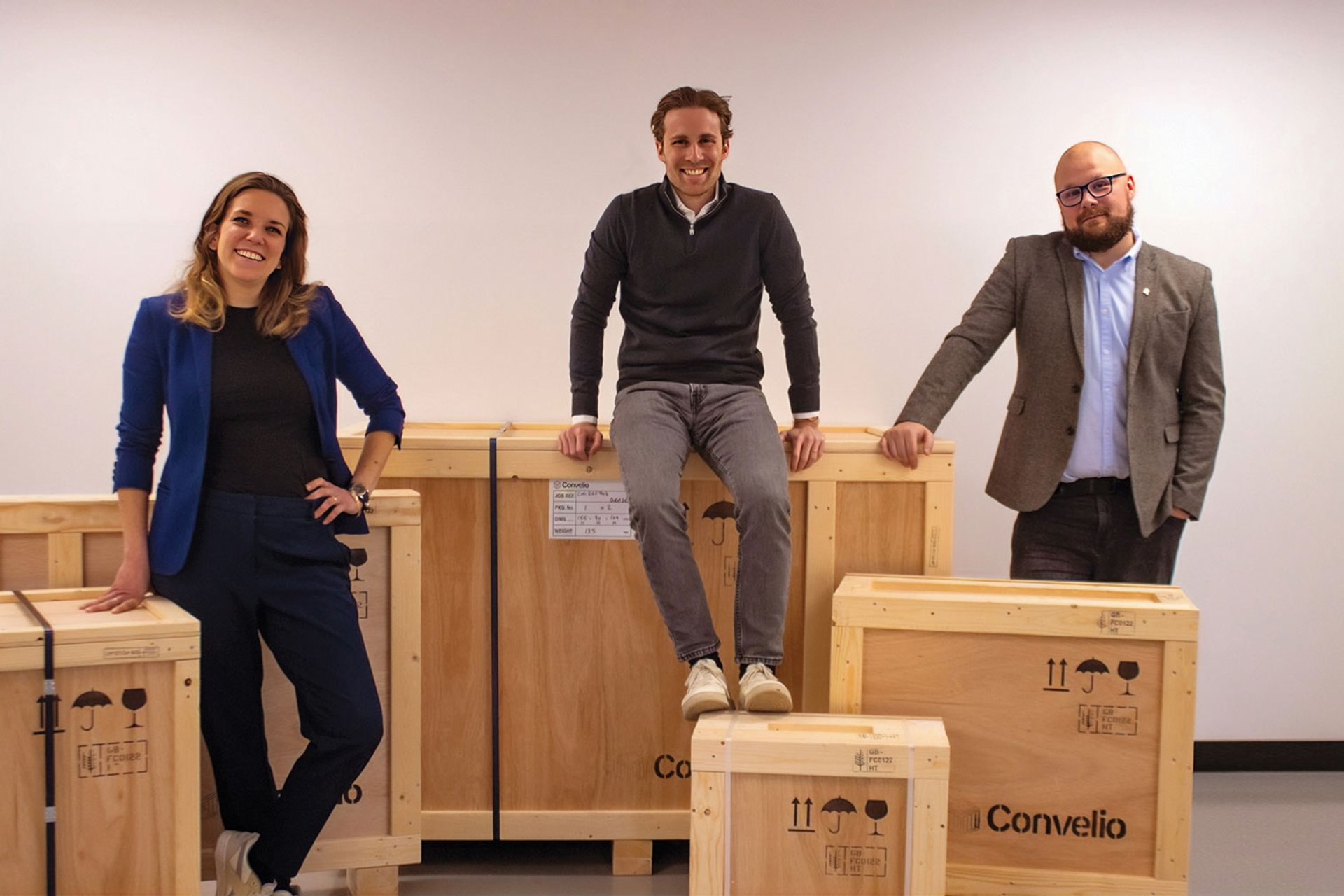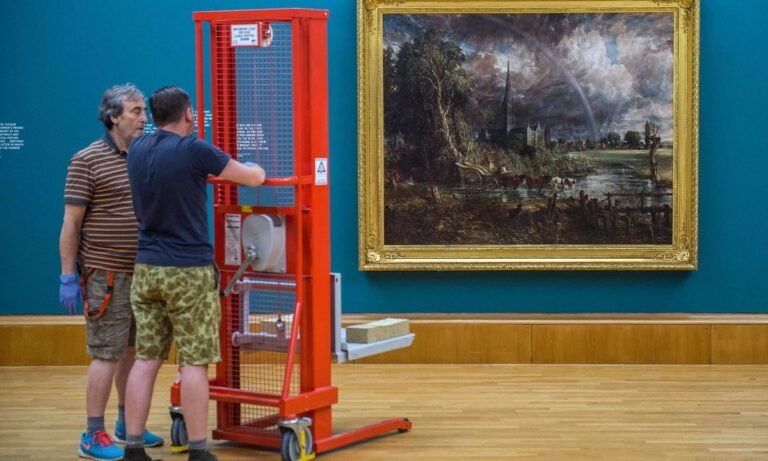The art industry’s “unsung heroes”. The people who make sure that multi-million-pound paintings get from A to B safely, who literally keep the lights on. Operations staff at museums, auction houses and commercial galleries may not have the public profile of sales directors and curators, but they are crucial to keeping the art world turning.
That is why the logistics firm Convelio, along with the recruiter SML, produced the first Convelio x SML Art Operations Talent Report last year, to give this behind-the-scenes cohort a voice. “In the tech and start-up world, operations are perceived as the star roles. But it’s totally the opposite in the art world,” says Edouard Gouin, the chief executive of Convelio, who worked in the tech and e-commerce world before he co-founded Convelio in 2017. Tech is still at the forefront—last month, Convelio launched a new AI-powered Art Inventory Management Software (IMS) and brought on the tech specialist Bernadine Bröcker Wieder, previously chief executive of the blockchain company Arcual, as an independent board member.
Since the mass layoffs in operations and logistics during the Covid-19 pandemic, many have left the art world in pursuit of higher salaries and greater job security in other sectors, Gouin says. “We’ve seen quite a lot of operations people moving to adjacent verticals, like luxury goods, or to biotech companies because moving something like an MRI scanner is very technical, not unlike a delicate work of art.”
Convelio’s report is based on 900 replies from surveys conducted in 2023 and 2024. Its aim, Convelio says, is to improve job satisfaction and recognition, and guide employers.
According to the report, employee confidence is low (scoring 51.2 out of 100), reflecting “growing concerns about job security and advancement opportunities”. Hence around half of respondents (35.7% of men and 64.3% of women) are actively seeking a new job. A contributing factor is that opportunities for career advancement are seen as lacking (scores of 2.66 out of 5 and 2.85 out of 5 respectively). While women, reportedly, earn around 3% more than men, this trend “varies significantly” by location and industry. Pay differences are stark, however, between white employees and those from other ethnic backgrounds—white individuals hold the vast majority of leadership positions (81.7%), and earn an average 44.9% more than their Asian colleagues, 9.3% more than Black colleagues and 10.4% more than Hispanic/Latino colleagues.
But, Gouin stresses: “We don’t want to be negative—you can make it to a top level in the art market in operations.” One of those whose career journey was documented in the report is Christie’s global head of operations, Julien Pradels. He oversees the largest team at the auction house, over 300 employees globally, ranging from gallery operations, bids and post-sale support to health and safety, security and art transport. “One of the things we discussed within the Convelio report was, how do you make these crucial roles feel more respected?” Pradels tells The Art Newspaper.
Christie’s hires numerous school and university leavers into its operations team, some via the apprenticeship scheme, but Pradels says a number of specialists have moved into operations from sales departments in the past couple of years, most with five to ten years’ experience. “I welcome these kinds of profiles because they already understand the spirit of the business and what it takes to produce a sale from start to finish.” A number have made this shift after having children, Pradels says: “It’s not that there is less pressure—we have significant working hours. But there is more a feeling of working as a big team, whereas sometimes as a specialist you might feel a bit on your own, feeling the pressure constantly to get consignments in.”
Rosie Allan, the managing director of SML, points out: “Some people want sales roles because they think it’s the way to earn lots of money, but it’s quite self-generated and your take-home pay can vary considerably depending on commission.” In operations, she says, “the sky’s the limit in terms of job progression, you might start as a registrar but end up as the COO or MD. The skills are very transferable—you could work in a gallery, in a museum, in a storage facility, for an auction house, for a shipper.”
As the administrative burden of customs procedures and compliance (such as Anti Money Laundering) has increased, so has a demand for registrars, Allan says. “Two or three years ago, we observed a greater demand for registrars and dwindling [numbers of] candidates apply, resulting in some galleries offering well above market rate salaries, particularly in New York. That’s dying out a bit now.”
Kate Thomson, a recruitment consultant at Draw Recruitment, concurs with Allan: “Brexit created a surge in requirements for registrars, particularly in around 2018, as works could no longer move freely through Europe.”
Salary transparency needed
According to the Convelio report, entry-level operations staff at a small company are on around €60,000 in London and New York and €63,000 in Paris, rising to around €116,000 (London), €106,000 (Paris) and €110,000 (New York) for senior roles. In large companies, those rise to around €69,000 (London), €71,000 (Paris) and €75,000 (New York) for entry-level roles, and around €176,000 (London), €181,000 (Paris) and €168,000 (New York) for the top jobs.
Those entry-level salaries will sound high to many in the art world and, in Thomson’s experience, “an entry level role in London would pay somewhere between £24,000 to £26,000 (€28,000 to €31,000), and a head registrar, from around £70,000 up to about £90,000. But there is no benchmark, greater transparency is needed.”

Edouard Gouin (centre), the chief executive of Convelio, a co-author of the survey report, with Bernadine Bröcker Wieder who joined the company as an independent board member last month
Alpha 6 Photography
The fine art logistics firm Gander & White, which received a Royal Warrant in December, employs around 350 people worldwide. At its headquarters in South London, entry-level salaries start “above the London Living Wage [currently around £27,000 per year, or £13.85 per hour]” says its executive operations director, Victor Khureya. The firm likes training people up from scratch: “We have a relationship with the local school, so we let them know when we’ve got a position coming up.” All the firm’s drivers start as art technicians, and the company pays for them to take their HGV licence—a significant expense. “We had a few people leave just after we paid for them to take the test so now they sign a contract agreeing to work for us for a minimum of three years afterwards, or they have to pay for the full training course,” says Alexander Bradford, the global business development and sustainability manager.
So what skills do you need to work as a registrar, or in the broad field of logistics? Numeracy is crucial, Allan says, as incorrect customs declarations can be very costly for the gallery. As can sending an entire 40ft container to the right city, in the wrong country, Khureya says: “I’ve heard of someone sending a container to Australia when it was meant to go to the US.”
“Part of being a good registrar is you have to tangibly show the value of that role and how much money you might have saved the gallery,” Allan says.
High net worth clients also come with high expectations, Khureya says: “Some of our clients will call us and ask, ‘Where is my Picasso?’ And we have to be able to say, ‘It’s in your house in San Francisco,’ for instance.”
Expectations can be high in other ways, too. “We had one client who turned up to let the boys in naked,” Bradford says, and Khureya adds: “Or some of our very wealthy female clients might take an, err, liking to one of our male employees, and then demand that any job must be done by that person.”
Hence, cool client-facing skills are also a must. “Some people crumble under stress,” Allan says. “Registrars often have to be the voice of reason and manage situations outside their control. It’s more personality traits than something that can be taught.”
But some things can be taught and a group of senior registrars from institutions and a couple of commercial galleries in the UK have established the first professional level cultural and creative registrar apprenticeship, equivalent to a degree. The group has worked with the National Gallery, the Courtauld Gallery, Royal Armouries, the National Trust, the Science Museum Group and the training provider Creative Alliance to design the scheme. The first apprentices start this summer.

